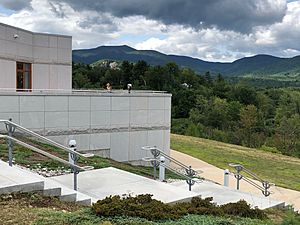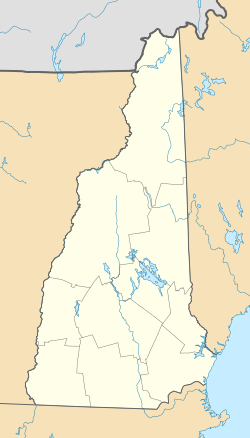Intervale, New Hampshire facts for kids
Quick facts for kids
Intervale, New Hampshire
|
|
|---|---|

The Intervale Scenic Vista along US 302 and NH 16
|
|
| Country | United States |
| State | New Hampshire |
| County | Carroll |
| Towns | Bartlett, Conway |
| Elevation | 554 ft (169 m) |
| Time zone | UTC-5 (Eastern (EST)) |
| • Summer (DST) | UTC-4 (EDT) |
| ZIP code |
03845
|
| Area code(s) | 603 |
| GNIS feature ID | 872079 |
Intervale is a small community in New Hampshire, United States. It's not a city or town with its own government. Instead, it's an unincorporated community. This means it's part of larger towns nearby. Intervale is located in Carroll County, New Hampshire. It sits right on the border between the towns of Bartlett and Conway.
Intervale is nestled in the beautiful White Mountains Region. It's also part of the Mount Washington Valley. This area is very popular for vacations. Other nearby communities in this resort area include North Conway and Jackson. Intervale even has its own special ZIP code (03845). This helps it stand out from the surrounding towns.
Exploring Intervale
Intervale is easy to find. It's located along two main roads: U.S. Route 302 and New Hampshire Route 16. These roads meet at Hurricane Mountain Road. Intervale is about 1.5 miles (2.4 km) north of the center of North Conway. Another road, New Hampshire Route 16A, goes north from Intervale. It passes through the village of Lower Bartlett.
Scenic Views and Rest Areas
One great spot in Intervale is a state highway rest area. It offers an amazing view of Mount Washington. You can also see the Presidential Range from here. These are some of the tallest mountains in New Hampshire. It's a perfect place to stop and enjoy the scenery.
A Glimpse into History
Intervale has a rich history. It was once home to a trading post run by Abenaki chief Joseph Laurent. This historic site is called the Abenaki Indian Shop and Camp. It is located near the state highway rest area. This important place is listed on the National Register of Historic Places. This means it's recognized for its historical value.
Images for kids




